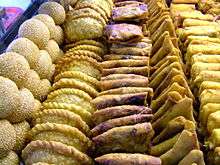Kue
Kue is an Indonesian bite-sized snack or dessert food. Kue is a fairly broad term in Indonesian to describe a wide variety of snacks; cakes, cookies, fritters, pies, scones, and patisserie.[1] Kue are made from a variety of ingredients in various forms, some are steamed, fried or baked.[2] Kue are popular snacks in Indonesia, which has the largest variety of kue. Because of the countries' historical colonial ties, Koeé (kue) is also popular in the Netherlands.[3]
Jajan pasar (market snacks) in Java, consisting of assorted kue | |
| Alternative names | Kueh (Hokkian), Kuih (Malaysia, Singapore, Brunei) |
|---|---|
| Course | Snack |
| Place of origin | Indonesia |
| Main ingredients | Various traditional snacks |
 |
| This article is part of the series on |
| Indonesian cuisine Masakan Indonesia |
|---|
|
Ingredients |
|
Styles |
|
Holidays and festivals |
|
Related cuisines |
|
|
Indonesian kue demonstrate local native delicacies, Chinese and Indian influences, as well as European cake and pastry influences. For example, bakpia and kue ku are Chinese Peranakan origin, kue putu is derived from Indian puttu, while kue bugis, klepon, nagasari, getuk, lupis and wajik are native origin, on the other hand lapis legit, kue cubit, kastengel, risoles and pastel are European influenced. In Java, traditional kues are categorized under jajan pasar (lit: "market buys" or "market munchies").[4] The well-set and nicely decorated colourful assorted jajan pasar usually served as a food gift, parcel or to accompany tumpeng (the main dish) during Javanese traditional ceremonies.
Etymology
The term "kue" is derived from Hokkien: 粿 koé.[5] It is also spelled as kuih in Malaysian, and kueh in Singapore. Kue are more often steamed than baked, and are thus very different in texture, flavour and appearance from Western cakes or puff pastries. Many kue are sweet, but some are savoury.
Indonesian kues are usually categorized according to its moisture. Roughly divided under two groups, kue basah (lit: "wet kue") and kue kering (lit: "dry kue"). In fact, the word kue in Indonesian language is used to refer to not only these kinds of traditional snack, but also all types of cake and some types of pastries. Most kue kering are technically pastries and many Western cakes can be considered as kue basah.[6]
Ingredients
Many of the traditional Indonesian kue, either sweet or savoury, are based on rice flour and coconut.[7] Traditionally, Indonesian sweets uses gula aren or palm sugar, yet powdered sugar or common sugar are also widely used. Rice flour and tapioca probably the most commonly used flour in Indonesian kue. However, due to foreign influences, wheat flour is commonly used. For creamy flavour and texture, traditional Indonesian cakes uses coconut milk, yet today dairy product such as milk, cream, butter, cheese and margarine are also commonly used. Popular flavouring agents and spices including coconut, peanut, green pandan, ginger, cinnamon, vanilla and chocolate.
Availability
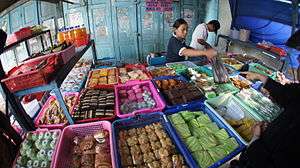
Today, in urban Indonesian society, an assorted choices of kue are popular snack for brunch or afternoon break to accompany coffee or tea.[8] Various traditional kue are often being offered alongside western pastries and cakes in cafes, coffee shops, snack stalls to humble warung kopi.
Traditionally, kue are made prior of certain celebration or events such as lebaran or natal. Indonesian households or community traditionally communally made homemade cakes for celebration and festivities. For example, Keraton Yogyakarta traditionally held Ngapem ceremony, where royal household communally cook kue apem (Javanese version of appam) as a part of Tingalan Jumenengan Dalem ceremony.[9] Nevertheless, kue is also a lucrative business, and traditionally available in traditional pasar pagi markets as jajan pasar (market buys).
Certain markets are specialized on selling various kue, such as Pasar Kue Subuh in Senen Central Jakarta, that selling kue from dawn to early morning. Visitors can indulge in traditional cakes and cookies, as well as modern ones. Most of the buyers in the Senen purchase in large quantities.[10]
In Indonesia, kue is one of popular street food choices. Some types of kue are marketed by street vendors in wheeled carts, either travelling around frequenting residential areas, or stationed in a busy sidewalk; such as near marketplace or in front of school. Certain kue vendors, such as kue rangi, getuk and kue putu are known ambulating residential areas, while kue ape, kue pancong, kue pukis and kue cubit sellers are often stationing their carts near marketplace or schools.
In the Netherlands, various asoorted selection of koeé are available in Indo toko and eetcafe snack shops.
Kue basah
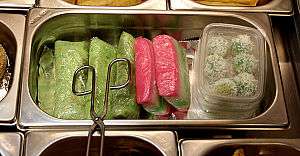
Most of traditional Indonesian kues are kue basah (wet kue).[4] Most are moist and soft in texture, steamed or fried instead of baked. Kue basah usually have rich coconut milk, sugar and rice flour content, and rather moist; as the result it can not last for more than a day or two,[6] especially in hot and humid Indonesian tropical climate,[11] in contrast to kue kering that might last longer.[12] The examples of kue basah are:
- Kue agar-agar, jelly-like substance pudding for dessert.
- Kue ape, thin wheat flour batter pancake with thicker part on the middle, colloquially called kue tetek (breast cake).[13][8]
- Kue apem, similar to Malay apam which ultimately derived from Indian appam. It is made of cassava tapai, coconut water, coconut sugar, rice flour, coconut milk, all mixed as a dough mixture and steamed until fluffy and cooked. Served with grated coconut.
- Kue arem-arem, rice cake snack made of compressed rice cake in the form of a cylinder wrapped inside a banana leaf, filled with diced vegetables, tempeh, oncom, minced meat or beef floss.
- Kue asida, dodol-like cake made of a cooked wheat flour lump of dough, sometimes with added butter or honey. It is popular during Ramadan.
- Kue bagea, round shape and creamy color cake made of sago. This cake has a hard consistency that can be softened in tea or water, to make it easier to chew.
- Kue bahulu, tiny crusty sponge cakes which come in distinctive shapes like button and goldfish, acquired from being baked in moulded pans. Bahulu is usually baked and served for festive occasions.
- Kue bakcang, glutinous rice stuffed with meat (usually pork) and wrapped in bamboo leaf in triangular (more precisely, tetrahedral) form.
- Kue bakpau, baozi filled with chocolate, strawberry, cheese, mung bean, read bean, minced beef, diced chicken, or minced pork.
- Kue bakpia, bean-filled Chinese pastry originally introduced by Fujianese immigrants. Today associated with Yogyakarta city.
- Kue bakpia pathok, round-shaped sweet rolls (bakpia), usually stuffed with mung beans.
- Kue barongko, banana cake made of mashed bananas, eggs, coconut milk, sugar and salt. Then wrapped in banana leaves and then steamed.
- Kue bibingka, baked rice cake made with rice flour, sugar, clarified butter, and coconut milk.
- Kue bika ambon, yellow porous cake made from tapioca and sago flour, eggs, sugar and coconut milk. Bika Ambon generally sold in pandan flavour, although now available also other flavors like banana, durian, cheese, chocolate.
- Kue bingka, cake made of mashed potato, flour, eggs, sugar, coconut milk, vanilla, milk and margarine, all mixed as dough and baked until golden brown and cooked. probably related to Philippines bibingka cake.
- Kue bitterballen, round-shape meat-based snack—almost similar to kroket.
- Kue bolen, baked pastry with crust layers similar to those of croissant, baked flour with butter or margarine layers, filled with cheese and banana. Other variants uses durian fillings. The cake demonstrate European pastry influences.
- Kue bolu beras, rice muffin cake.
- Kue bolu gulung, swiss roll cake filled with butter cream, cheese, kaya, or fruit jam. It is also very common for swiss rolls to be sold by the slice, but some shops sell by both slice and roll.
- Kue bolu kukus, steamed bun made of flour, sugar, eggs, margarine, and vanilla or chocolate flavouring.
- Kue brem, fermented-tapai-based cake.
- Kue bugis, steamed glutinous rice flour and tapioca colored green with pandan, filled with grated coconut and coconut sugar, wrapped inside banana leaf.
- Kue bulan, circular cake like a moon, white and thinner than regular mooncake. Fillings may include pork, chocolate, cheese, milk, durian, jackfruit and many other exotic fruits made into a paste.
- Kue burgo, folded rice pancake served in savoury whitish coconut milk-based soup, flavoured with fish, and sprinkled with fried shallots.
- Kue busa, sweet pastry made of eggs that are beaten until foamy with fine sugar until stiff. Formed using triangular plastic and baked in the oven.
- Kue cakwe, long golden-brown deep-fried strip of dough and commonly chopped or thinly sliced and usually eaten for breakfast with bubur ayam.
- Kue carabikang, traditional cake made of rice flour shaped like flower-chapped and colorful. It tastes sweet.
- Kue cendil, rice flour-based small glutinous cake, sweetened with sugar, moulded and coloured. Served with fresh grated coconut.
- Kue cilok, ball-shaped dumpling made from tapioca starch.
- Kue cincin, deep fried dough pastry-based snack
- Kue clorot, the sticky dough of glutinous rice flour sweetened with coconut sugar filled into the cone-shaped janur (young coconut leaf), and steamed until cooked.
- Kue combro, fritter cake made from grated cassava with round or oval-shape. Combro can filled with oncom and chili.
- Kue cubit, made of flour, baking powder, sugar and milk—as their primary ingredients. The liquid dough is poured inside a steel plate with several small round basins so that it will form round shape .when cooked, and poured with meises (chocolate granules not unlike sprinkles) on top of it. The seller uses some kind of special hooked stick to take the cake off from the steel plate. This cake is called kue "cubit" (Indonesian: pinch) because of its small bite size, to eat it one have to pinch it.[8]
- Kue cucur, pancake made of fried rice flour batter and coconut sugar.
- Kue dadar gulung, grated coconut with coconut sugar wrapped inside a thin crepe made of rice flour. The dadar (crepe) is usually colored green.
- Kue dangke, traditional cheese that made from buffalo or cow milk.
- Kue dodol, rice flour-based small glutinous sweets, sweetened with coconut sugar, moulded and coloured. Often add fruit scent and taste such as durian.
- Kue dodol susu, milk dodol cake.
- Kue donat jawa, traditional doughnut snack, typically savoury, made of cassava instead of potato or flour.
- Kue ganjel rel, rectangular-shaped brown cake with sesame seeds, flavored with cinnamon and palm sugar.
- Kue gemblong, made of glutinous rice flour formed into a ball, deep fried and then coated with palm sugar.
- Kue geplak, sweet cake made of grated coconut and sugar, often brightly colored.
- Kue getuk, made of cassava flour and coconut sugar, served with sweetened grated coconut.
- Kue jalangkote, fried pastry with an empanada-shape and stuffed with vegetables, potatoes and eggs. Spicy, sweet and sour sauce will be dipped into prior to be eaten.
- Kue jemput-jemput, fritter snack made from flour and then fried. It is usually round in shape and tends to vary in size.
- Kue kamir, round-shaped cake that almost similar to apem, consists of flour, butter, and egg mixture, sometimes mixed with other ingredients such as banana or tapai.
- Kue karipap, small pie consisting of curry with chicken and potatoes in a deep-fried or baked pastry shell. It can be also filled with meat mixed with vegetables (chopped carrot and beans), rice vermicelli, and sometimes egg, then deep fried in vegetable oil.
- Kue keranjang, traditional cake made of glutinous rice flour and consumed during Chinese New Year.
- Kue keria, fried doughnuts made with a sweet potato batter and rolled in caster sugar.
- Kue klappertaart, coconut tart, specialty of Manado city, North Sulawesi.
- Kue klepon, balls of glutinous rice flour filled with gula jawa (red coconut sugar), boiled or steamed. The balls are rolled upon grated coconut as the coconut granules stuck upon the balls. It is called "onde-onde" in Sumatra and Malay Peninsula
- Kue kochi, dumpling cake made from glutinous rice flour, and stuffed with coconut fillings with palm sugar. This cake often as a dessert and can be eaten anytime (during breakfast or tea time).
- Kue kompia, bread cake made with lard, onions, salt and flour.
- Kue kroket, Indonesian version of potato croquette, introduced during the Dutch colonial rule. The kroket is made of potato and minced chicken inside a crepe-like wrapper is one of the popular snack items in Indonesia. The kroket is made by taking a potato and chicken filling and wrapping it inside a crepe-like wrapper, breaded, and fried.
- Kue ku, Chinese-origin kue of sticky rice flour with sweet filling. The same as Chinese "ang ku kueh".
- Kue laklak, traditional little pancake made of rice flour, suji leaf extract and baking powder with grated coconut and melted palm sugar.
- Kue lapis, layered colorful cake made of glutinous rice flour, coconut and sugar
- Kue lapis legit, also known as Kue lapis Batavia or spekkoek (layer cake) is a rich kue consisting of thin alternating layers made of butter, eggs and sugar, piled on top of each other. Each layer is laid down and then grilled separately, making the creation of a kueh lapis an extremely laborious and time-consuming process.
- Kue leker, stuffed crepe. Semicircle in shape and crusty in texture, it is generally filled with a spatter of sweetened condensed chocolate milk or grated cheese. Its name was derived from the Dutch word lekker which roughly means "delicious".[8]
- Kue lemper, made of glutinous rice filled with chicken, fish or abon (meat floss). The meat filling is rolled inside the rice, in a fashion similar to an egg roll.
- Kue lumpia, spring roll made of thin paper-like or crepe-like pastry skin called "lumpia wrapper" enveloping savory or sweet fillings. It is often served as an appetizer or snack, and might be served deep fried or fresh (unfried).
- Kue lupis, compressed glutinous rice served with grated coconut and coconut sugar syrup.
- Kue madumongso, snack made from black sticky rice as a basic ingredient. The taste is mixed with sweet because the black rice is previously processed before it becomes tapai.
- Kue makmur, traditional cake made from butter, ghee and flour. Served during special occasion of Eid al-Fitr and identified with its white colour and usually in a round shape.
- Kue mangkok Indonesian traditional cupcake, usually sweetened with palm sugar or tapai (fermented cassava).
- Kue martabak, stuffed pancake or pan-fried bread. This appetizer is spicy folded omelette pancake with bits of vegetables, sometimes mixed with green onion and minced meat, made from pan fried crepes which is folded and cut to squares.
- Kue moci, the same recipe and derived from Japanese mochi, glutinous pounded rice flour filled with sweet peanut paste. Some variant covered with sesame seeds, other might be plain.
- Kue nagasari or kue pisang, traditional steamed cake made from rice flour, coconut milk and sugar, filled with slices of banana.
- Kue nopia, palm sugar-filled pastry smaller size than bakpia.
- Kue oliebol, dumpling cake of fried bread.
- Kue ombusombus, sticky rice cake with palm sugar filling, rolled in coconut flakes.
- Kue onde-onde, the same as Chinese jian dui. In Sumatra, onde-onde refer to klepon.
- Kue ongol-ongol, sweet cake made of sago, salt, pandan leaf and palm sugar.
- Kue pai ti, thin and crispy pastry tart shell kue filled with a spicy, sweet mixture of thinly sliced vegetables and prawns.
- Kue panada, fried bread cake filled with spicy tuna.
- Kue pancong, rice flour and coconut milk cake.[8]
- Kue pandan, fluffy cake made of eggs, sugar, and flour, flavoured with Pandanus extract, usually colored light green.
- Kue pastel, pie of crust made of thin pastry filled with meat (usually chicken) mixed with vegetables (chopped carrot and beans), rice vermicelli and sometimes egg, then deep-fried in vegetable oil. It is thought to be of Portuguese origin. Its shape is similar to Malaysian karipap (curry puff) but curry paste/powder is absent.
- Kue pastel de nata, egg tart pastry dusted with cinnamon, derived from Portuguese cuisine.
- Kue pau, word for 'bun'; sometimes written as bak-pau, literally meaning 'meat-bun', which is a bun with meat fillings.
- Kue pinyaram, traditional cake made from mixture of white sugar or palm sugar, white rice flour or black rice, and coconut milk.
- Kue pisang cokelat, savoury snack made of slices of banana with melted chocolate or chocolate syrup, wrapped inside thin crepe-like pastry skin and being deep fried.
- Kue pisang goreng, battered and deep-fried banana or plantain.
- Kue pisang molen, fried banana wrapped in stripe of wheat flour dough. The term molen refer to "mill" in Dutch, suggested its Dutch influence.
- Kue poffertjes, Dutch batter pancakes, demonstrate Dutch influences on Indonesian cuisine.
- Kue popiah, spring roll with Chinese-origin and Fujian-style. This dish almost equal to lumpia.
- Kue pukis, cake that made from egg mixture, granulated sugar, flour, yeast and coconut milk. The mixture is then poured into a half-moon mold and baked on fire (not oven). Pukis can be said to be actually a modification of waffles.
- Kue putu, rice flour with green pandan leaf coloring, cooked with palm sugar filling, steamed in bamboo pipes, and served with grated coconut.
- Kue putu mangkok, round-shaped, traditional steamed rice flour kue or sweet snack filled with palm sugar. This cake similar to kue putu.
- Kue putu mayang, idiyappam-like cake that made from starch or rice flour shaped like noodles, with a mixture of coconut milk, and served with kinca or liquid javanese sugar.
- Kue rangi, coconut waffle, made from sago flour mixed with shredded coconut and served with a splash of palm sugar sauce.[8]
- Kue risoles, a mixture of minced meat, beans and carrots wrapped inside thin flour omelette, covered with bread crumbs and fried.
- Kue samosa, fried or baked dumpling kue with a savoury filling, such as spiced potatoes, onions or peas.
- Kue semar mendem, variants of lemper, instead wrapped with banana leaf, the glutinous rice filled with chicken, fish or meat floss is wrapped inside thin egg omelette.
- Kue serabi, traditional pancake that is made from rice flour with coconut milk or just plain shredded coconut as an emulsifier.
- Kue soes, a baked pastry filled with soft and moist cream made from the mixture of milk, sugar and flour.
- Kue spiku, similar ingredient to lapis legit but only have three layers of plain and chocolate flavour layered cake.
- Kue talam, literally means "tray cake", made of rice flour, coconut milk and sugar steamed in cake mold or cups.
- Kue timphan, steamed banana and glutinous rice cake wrapped in banana leaf from Aceh.
- Kue wajik, a diamond-shaped compressed sweet glutinous rice cake.
- Kue wingko, a traditional Javanese pancake-like snack made from coconut.
Kue kering
In Indonesian language kue kering (dried kue) is identical to cookies, both traditional or western derived.[14] Almost all of kue kering are baked or fried with no or minimal water content, thus they has longer shelf life compared to easily spoiled kue basah.[6] Some variant, especially kaasstengels clearly demonstrate Dutch origin (kaas is Dutch word for cheese). Because it is dried, it last longer than kue basah. Kue kering often served during annual holidays and important festivities, popular to be offered for visiting guests during Lebaran and Natal. Examples of kue kering are:
- Kue akar kelapa
- Kue bangkit, sagoo cookie
- Kue bola keju
- Kue cistik (kue cheese stick)
- Kue durian renyah
- Kue gapit, tapioca waffle
- Kue jahe
- Kue keju suiker
- Kue Kaasstengels, cheese cookie
- Kue kacang sabit
- Kue kering coklat
- Kue keciput (kue buah rotan)
- Kue kelapa
- Kue kopi kelapa
- Kue kurma
- Kue kuping gajah
- Kue lanting
- Kue leker
- Kue lidah kucing
- Kue nastar
- Kue nastar cengkeh
- Kue nastar keju
- Kue nastar lemon
- Kue putri salju, cookies coated with white powdered sugar
- Kue semprong, cone shaped crispy flour and sugar thin layer
- Kue sagu
- Kue sagu keju
- Kue satu or kue koya
- Kue semprit
- Kue sus kering keju
- Kue tambang
- Kue telur gabus
Gallery
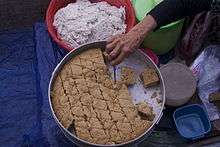 Kue apem at Lok Baintan Floating Market
Kue apem at Lok Baintan Floating Market
- Kue bagea kenari
- Kue bangkit
- Kue bika Ambon
 Kue carabikang
Kue carabikang- Kue cenil
 Kue clorot or cerorot
Kue clorot or cerorot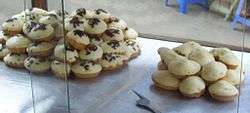
- Kue dadar gulung
- Kue nagasari
- Kue klepon
 Kue moci
Kue moci Kue moho
Kue moho- Kue putu mayang
 Kue pukis
Kue pukis- Putri salju
 Lapis legit and kue lapis
Lapis legit and kue lapis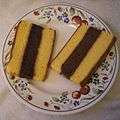 Kue lapis Surabaya
Kue lapis Surabaya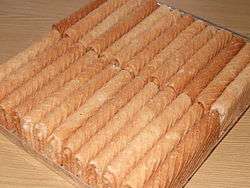 Kue semprong
Kue semprong Kue timphan
Kue timphan- Kue ku, derived from Chinese Ang Ku Kueh
- Kue lumpang
- Kue lumpur surga
 Kue ongol-ongol
Kue ongol-ongol- Kue risoles
- Kue pastel
 Kue wingko babad
Kue wingko babad
See also
References
- "Kue". Kamus.net. Retrieved 22 October 2012.
- "Hasil Pencarian - KBBI Daring". kbbi.kemdikbud.go.id. Retrieved 2018-07-02.
- Indonesisch Kookboek Selamat Makan (PDF). Koninklijke Marine. 1999.
- Alamsyah, Yuyun (2006). Kue basah & jajan pasar: warisan kuliner Indonesia (in Indonesian). Gramedia Pustaka Utama. ISBN 9789792221527.
- "Kata Serapan Bahasa Cina". Scribd. Retrieved 2018-07-02.
- "Perbedaan Kue Basah dan Kue Kering Yang Kamu Mungkin Belum Tahu". Inspirasi Baking by PT Sriboga Flour Mill. 2018-04-27. Retrieved 2018-07-02.
- "Indonesian Desserts Recipes | Asian Recipes". www.asian-recipe.com. Retrieved 2018-07-02.
- Post, The Jakarta. "5 perfect traditional snacks for a get-together". The Jakarta Post. Retrieved 2018-07-02.
- "Para Puteri Sri Sultan Luwes Membuat Apem di Prosesi Ngapem - Tribun Jogja". Tribun Jogja (in Indonesian). 2018-04-14. Retrieved 2018-07-02.
- Post, The Jakarta. "Weekly 5: Traditional markets around the clock". The Jakarta Post. Retrieved 2018-07-02.
- Muhammadi, Fikri Zaki. "Traditional delicacies survive modern cake invasion". The Jakarta Post. Retrieved 2018-07-02.
- Lestari, Dapur (2013-02-05). 101 KUE NUSANTARA (in Indonesian). Puspa Swara. ISBN 9786028453684.
- "Getting to know the local crispy pancake 'kue ape'". The Jakarta Post. Retrieved 2018-07-02.
- Anissa, Dapur (2013-05-13). 100 Resep Kue Kering Klasik (in Indonesian). Gramedia Pustaka Utama. ISBN 9786020340654.
External links
| Wikimedia Commons has media related to Kue. |
